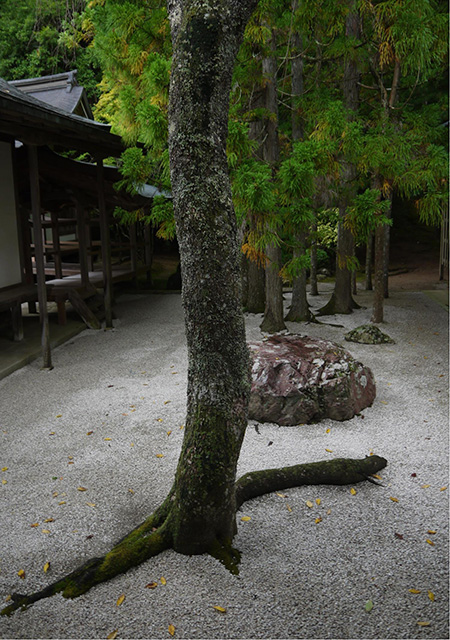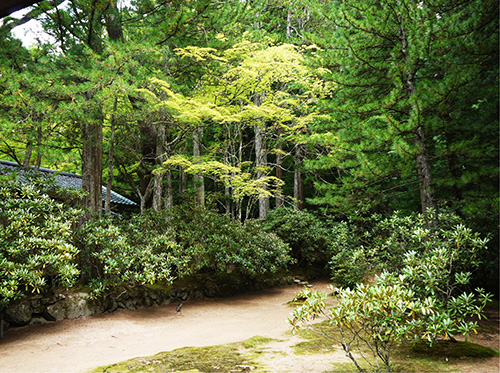


金剛峯寺探訪、きょうは主屋から「離れ」空間への移動の縁から。
日本の住宅文化の中にこういった「通路空間」の演出要素は
相当の洗練が積層していると思います。
たぶん日本人のメンタルの部分で連綿と繋がっている感受性要素。
多様な植生を育んでいる本州以南の気候風土で、
それらのハーモニーを楽しむ文化要素が発達したのだろうと思います。
そのなかでもひとつの大きな要素が「白砂」の活かし方ではないかと。
龍安寺の石庭のような、人工加工的な地盤面整備を施すことで、
逆に植物の「生命感」を浮かび上がらせるという手法でしょう。
龍安寺ではそれが一種の極限化が見られて「人間、最後は石だ」みたいな
見るフェチズムの極限のような景観を造形している。
この金剛峯寺にも石庭がありますが、そこへの移動アプローチでも見られる。
さらにいえば、建物間を移動するという文化も
本州以南日本では発達していると感じさせられる。
残念ながらこの部分は積雪寒冷の北海道では受容しがたかった部分です。
半年の間、積雪寒冷。雪が積もってその間微妙な陰影感は消失する。
ようやく春になって雪が融けてもとりあえずは復旧作業しなければならない。
繊細微妙な植生演出をしても本当に楽しめるのは数ヶ月程度で
景色の復旧に1ヶ月近くかかり、雪で死滅する植生もあるので
植え替えたりする手間暇もある。植え替えても鑑賞まで数年のスパンが必要になる。
・・・気候がこういう日本文化に適合しない。
なので北海道ではこういった方向には住文化として発展が向かわなかった。
本州以南的な「花鳥風月」とはまったくちがった地平から
再度、スパンの拡大した新たな「花鳥風月」を創造する以外にない。
いやむしろ、住宅よりはアクティブに大自然そのものを感受する方向が刺激された。
箱庭的な自然いじりよりも、潔くそのなかに身を置く方の文化。
そうではあるのですが、
しかし白砂を魅力的な結界表現として活用して幽玄さを表現するという
こういった精神性の深みもまた、大いに刺激してくれる。
なにげない樹木の造形ぶりが、白砂でコントラストを付けてあげることで
なんとも美感を訴求してくる。
たぶん南北に長く亜寒帯と亜熱帯気候が同居する日本文化社会のなかで、
亜寒帯の方はまだまだ自分の文化を十分に創造できていない。
亜熱帯とはまったく違うことはあきらかなんだけれど、
基本的な日本の「常識」としては亜熱帯特化型で基板形成されているので、
いろいろと文化ギャップが生み出されてくる、ということなのでしょう。
やっぱり北の方から、新たな「花鳥風月」の再構築が必要なんでしょうね。
English version
[Green / white sand, to the beauty of the garden where you can feel the material Koyasan / Kongobuji Temple-9]
Visit Kongobuji Temple, today from the edge of moving to a space “away” from the main building.
The directing element of such a “passage space” in Japanese housing culture
I think there is a lot of sophistication.
Perhaps a sensitive element that is connected to continuous cotton in the Japanese mental part.
In the climate south of Honshu, where diverse vegetation is nurtured,
I think that the cultural elements to enjoy those harmonies have developed.
One of the big factors is how to utilize “white sand”.
By applying artificially processed ground surface maintenance like the stone garden of Ryoanji Temple,
On the contrary, it is a method to bring out the “life feeling” of plants.
At Ryoanji, that is a kind of extreme, like “human beings, the last is stones”.
It creates a landscape that looks like the limit of fetishism.
This Kongobuji Temple also has a stone garden, but you can also see it on a moving approach to it.
Furthermore, the culture of moving between buildings
It makes me feel that it is developing in Japan.
Unfortunately, this part was unacceptable in snowy and cold Hokkaido.
For half a year, the snow is cold and the snow is piled up, and the subtle shadows disappear during that time.
Finally in spring, the snow melts and I have to restore it for the time being.
Even with delicate vegetation production, you can really enjoy it in a few months.
It takes nearly a month to restore the scenery, and some vegetation is killed by snow.
There is also time and effort to replant. Even if it is replanted, it will take several years.
… The climate does not suit this kind of Japanese culture.
Therefore, in Hokkaido, development was not seen as a living culture in this direction.
From a horizon completely different from the “Kacho Fugetsu” south of Honshu
There is no choice but to create a new “Kacho Fugetsu” with an expanded span again.
Rather, it stimulated the direction of feeling the nature itself as a region rather than housing.
The culture of those who put themselves in it rather than messing around with nature like a miniature garden.
That’s right,
However, it is said that white sand is used as an attractive barrier expression to express mystery.
This depth of spirituality is also very inspiring.
By adding contrast with white sand, the shape of a casual tree
It appeals to the beauty.
Perhaps in a Japanese cultural society where the subarctic and subtropical climates coexist for a long time from north to south.
People in the subarctic region have not yet fully created their own culture.
It’s clear that it’s completely different from the subtropics,
As a basic Japanese “common sense”, the substrate is formed in a subtropical specialization type, so
It seems that various cultural gaps will be created.
After all, it is necessary to rebuild a new “Kacho Fugetsu” from the north.
Posted on 11月 3rd, 2021 by 三木 奎吾
Filed under: 住宅マーケティング, 日本社会・文化研究








 】
】
コメントを投稿
「※誹謗中傷や、悪意のある書き込み、営利目的などのコメントを防ぐために、投稿された全てのコメントは一時的に保留されますのでご了承ください。」
You must be logged in to post a comment.